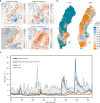Drought alters the biogeochemistry of boreal stream networks
- PMID: 32286262
- PMCID: PMC7156665
- DOI: 10.1038/s41467-020-15496-2
Drought alters the biogeochemistry of boreal stream networks
Abstract
Drought is a global phenomenon, with widespread implications for freshwater ecosystems. While droughts receive much attention at lower latitudes, their effects on northern river networks remain unstudied. We combine a reach-scale manipulation experiment, observations during the extreme 2018 drought, and historical monitoring data to examine the impact of drought in northern boreal streams. Increased water residence time during drought promoted reductions in aerobic metabolism and increased concentrations of reduced solutes in both stream and hyporheic water. Likewise, data during the 2018 drought revealed widespread hypoxic conditions and shifts towards anaerobic metabolism, especially in headwaters. Finally, long-term data confirmed that past summer droughts have led to similar metabolic alterations. Our results highlight the potential for drought to promote biogeochemical shifts that trigger poor water quality conditions in boreal streams. Given projected increases in hydrological extremes at northern latitudes, the consequences of drought for the health of running waters warrant attention.
Conflict of interest statement
The authors declare no competing interests.
Figures






References
-
- Lu X, et al. Drought rewires the cores of food webs. Nat. Clim. Chang. 2016;6:875–878. doi: 10.1038/nclimate3002. - DOI
-
- Van Loon AF, et al. Drought in the Anthropocene. Nat. Geosci. 2016;9:89–91. doi: 10.1038/ngeo2646. - DOI
-
- Wang W, Ertsen MW, Svoboda MD, Hafeez M. Propagation of drought: from meteorological drought to agricultural and hydrological drought. Adv. Meteorol. 2016;2016:1–5.
Publication types
LinkOut - more resources
Full Text Sources
Miscellaneous

